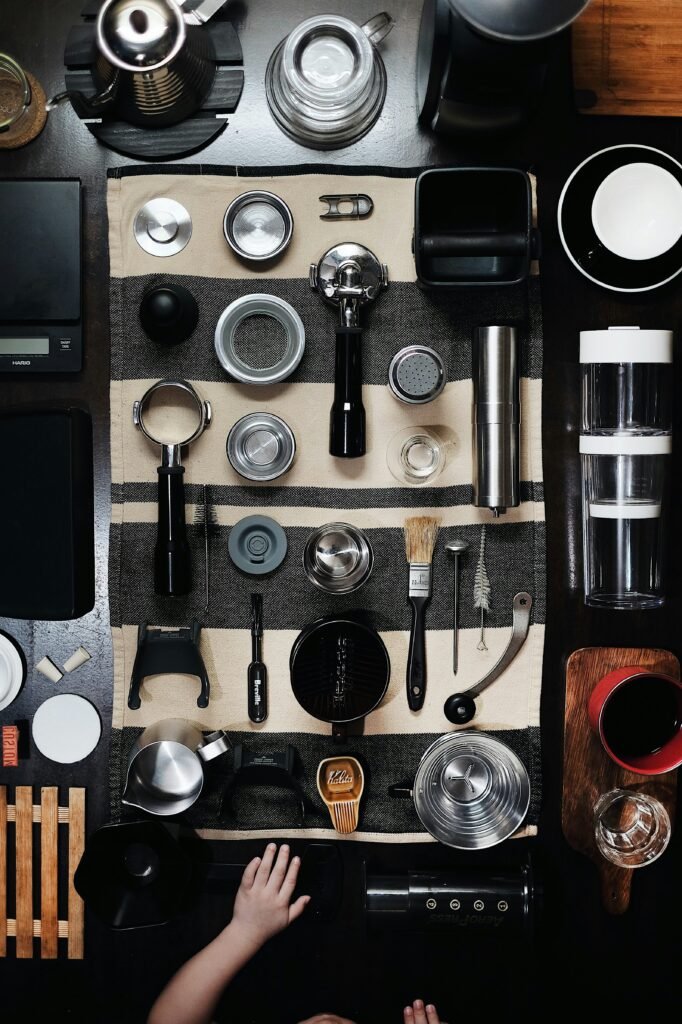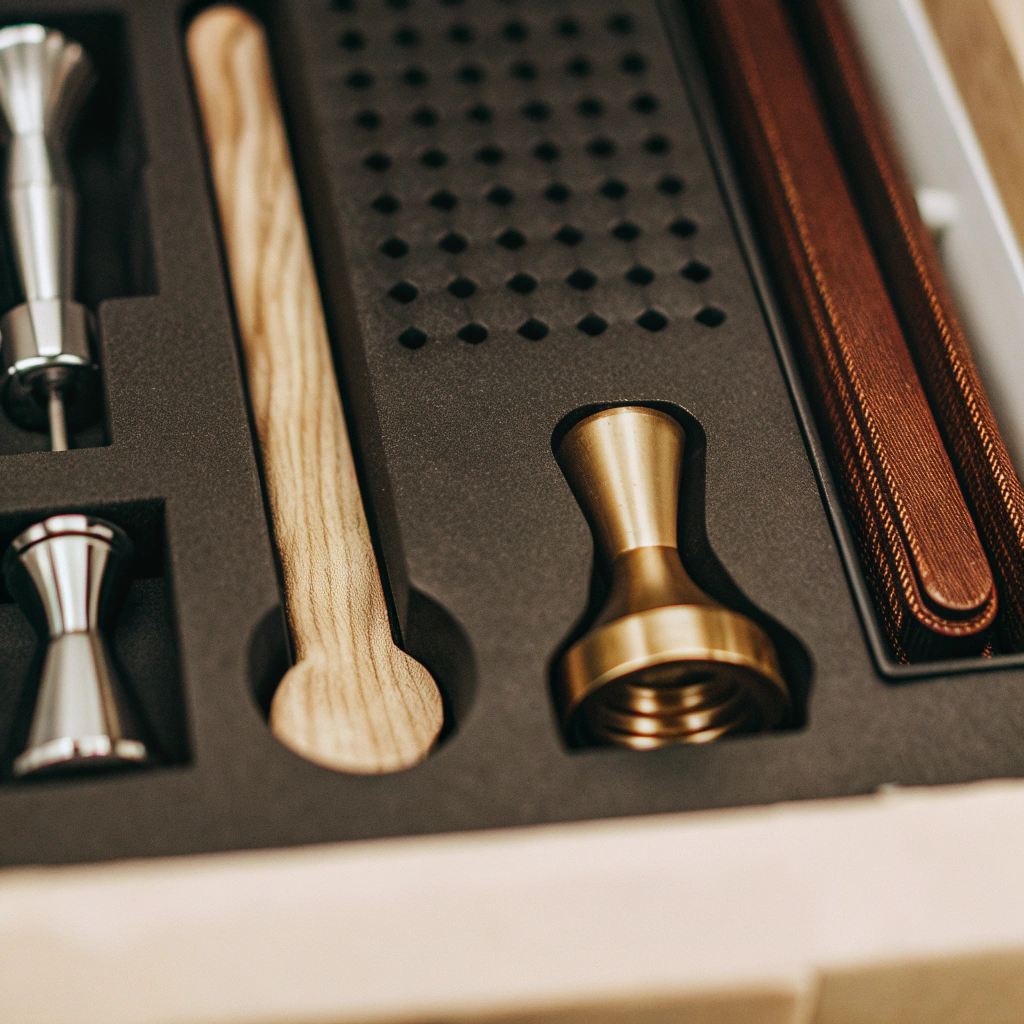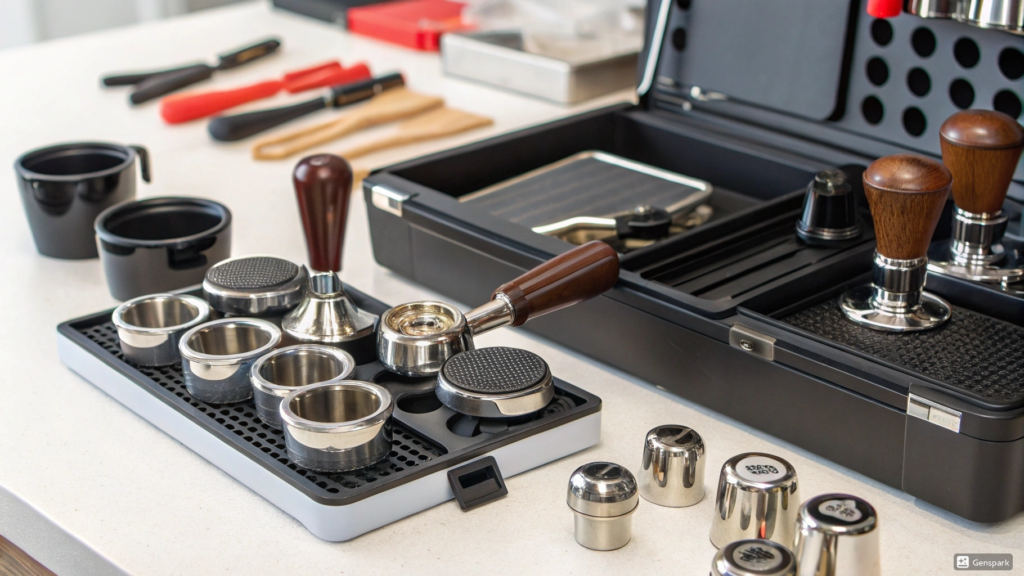Selecting Espresso Tools for Commercial Kitchens: A Buyer's Guide for Restaurant Owners?
Choosing the wrong espresso tools can cost restaurant owners thousands in wasted coffee, inconsistent drinks, and equipment breakdowns. Your profits and reputation depend on making the right investments.
The ideal commercial espresso setup requires precision-engineered tools specifically designed for high-volume use. Restaurant owners should prioritize food-grade stainless steel accessories (portafilters, baskets, tampers) that maintain consistency across multiple baristas while withstanding intensive daily cleaning protocols.

I've worked with hundreds of restaurant owners setting up their espresso programs. The difference between successful coffee programs and struggling ones often comes down to equipment choices. Let me share what I've learned from supplying commercial kitchens across the Middle East and Europe.
What espresso tools do restaurant kitchens actually need?
Restaurant owners often waste money on unnecessary gadgets while missing essential tools. This leads to workflow inefficiencies and inconsistent drinks that frustrate both staff and customers.
A commercial espresso setup requires six essential tools: precision filter baskets (ridged and ridgeless), heavy-duty portafilters with ergonomic handles, calibrated tampers, distribution tools, knock boxes, and proper cleaning supplies. These core items ensure consistent extraction across different baristas while maintaining high-volume efficiency.

Breaking Down the Commercial Espresso Toolkit: Essential vs. Optional
Having supplied restaurants across multiple countries, I've observed which tools truly impact daily operations versus those that simply add complexity. The right combination of workhorse tools creates an efficient workflow that can handle peak service periods without compromising quality.
Let's analyze the essential espresso tools for commercial kitchens in detail:
Commercial Espresso Tool Priority Chart
| Tool Category | Essential Items | Recommended Specifications | Impact on Operations |
|---|---|---|---|
| Filter Baskets | Precision ridged & ridgeless | 304/316 stainless steel, 18-22g capacity | High: Directly affects extraction consistency |
| Portafilters | Commercial-grade | Brass/chrome-plated, ergonomic handles | High: Durability during continuous use |
| Tampers | Calibrated, ergonomic | 58-58.5mm precision fit, adjustable pressure | Medium-High: Reduces barista variability |
| Distribution Tools | Simple but effective | Needle-style or flat base | Medium: Ensures even extraction |
| Knock Boxes | Commercial size | Rubber-lined, dishwasher safe | Medium: Workflow efficiency |
| Cleaning Tools | Backflushing discs, specialized detergents | Chemical-resistant materials | High: Maintains equipment longevity |
Beyond these essentials, secondary tools like shot mirrors, dosing funnels, and precision scales offer incremental improvements but aren't critical for most operations. I've found that restaurants often achieve better results by investing in higher quality versions of the essential tools rather than expanding their toolkit with specialized gadgets.
In high-volume environments, tool durability becomes particularly important. For example, standard consumer tampers typically last 3-6 months in commercial settings, while professional-grade versions with hardened stainless steel bases can survive 2+ years of intensive use. This represents significant cost savings over time while ensuring more consistent drink quality.
How do material choices impact commercial espresso tool performance?
Cheap espresso tools often use low-grade metals that corrode, warp under pressure, or contaminate coffee with metallic tastes. These problems compound in high-volume settings where equipment faces constant stress.
Commercial-grade espresso tools should feature certified food-safe materials like 304/316 stainless steel for baskets and shower screens, chrome-plated brass for portafilters, and food-grade silicone for gaskets. These materials withstand the heat cycles, pressure stress, and chemical cleaning agents common in restaurant environments.

Material Science in Commercial Espresso Equipment
The harsh environment of commercial kitchens places extreme demands on espresso tools. Through my manufacturing experience, I've learned that material selection dramatically affects both tool performance and longevity. Poor material choices lead to hidden costs through frequent replacements and inconsistent beverage quality.
Commercial kitchens create uniquely challenging conditions for espresso tools:
- Temperature fluctuations (from room temperature to 200°F+)
- Continuous pressure stress (9+ bars during extraction)
- Chemical exposure (cleaning agents, descalers, water minerals)
- Physical impact (tamping forces, knocking out pucks)
- Constant moisture exposure
Each material responds differently to these challenges. Here's how various metals commonly used in espresso tools perform in commercial settings:
| Material | Advantages | Disadvantages | Best Applications | Maintenance Requirements |
|---|---|---|---|---|
| 304 Stainless Steel | Corrosion resistant, durable, neutral taste | Higher cost, can scratch | Filter baskets, shower screens | Low: regular cleaning |
| 316 Stainless Steel | Superior corrosion resistance, longest lifespan | Premium cost | Precision baskets for high-volume | Low: regular cleaning |
| Brass | Excellent thermal properties, durable | Can leach if not properly plated | Portafilter bodies, group heads | Medium: requires descaling |
| Aluminum | Lightweight, good heat conductor | Corrosion prone, shorter lifespan | Budget tampers, distribution tools | High: requires careful drying |
| Chrome-Plated Steel | Good appearance, moderate cost | Plating can wear or chip | Mid-range portafilters | Medium: inspect for plating damage |
For restaurant owners, understanding these material differences translates directly to operational efficiency. For example, investing in 316 stainless steel baskets can extend replacement cycles from every 6 months to 2+ years in high-volume cafes. Similarly, solid brass portafilters maintain more stable temperature during extraction, resulting in more consistent espresso across dozens of shots.
From my experience supplying Middle Eastern markets where mineral-rich water is common, I've seen how material choices become even more critical. Restaurants in these regions that invest in marine-grade stainless steel components typically see 3-4 times longer service life compared to those using standard components.
What's the real cost of quality espresso tools for restaurants?
Restaurant owners often purchase cheap espresso tools only to replace them frequently. This false economy costs more long-term while delivering inferior drinks that damage reputation and customer loyalty.
Professional espresso tools represent a higher initial investment but offer superior durability and performance. A complete set of commercial-grade tools (portafilters, precision baskets, calibrated tampers, and distribution tools) typically costs $300-600 but will last 3-5 years in high-volume environments versus 6-12 months for consumer-grade alternatives.

The Economics of Espresso Tool Investment for Restaurants
As a manufacturer supplying restaurant equipment distributors, I've tracked the lifecycle costs of different quality tiers across hundreds of installations. The data clearly shows that tool quality directly impacts both operational expenses and revenue potential. This analysis helps restaurant owners make informed decisions based on their specific business model.
When evaluating the true cost of espresso tools, we need to consider several factors beyond the initial purchase price:
Total Cost of Ownership Analysis: Commercial Espresso Tools
| Cost Factor | Economy Tools | Mid-Range Tools | Professional-Grade Tools |
|---|---|---|---|
| Initial Investment | $100-200 | $200-400 | $400-800 |
| Average Lifespan (commercial use) | 3-6 months | 1-2 years | 3-5+ years |
| Replacement Frequency (5-year period) | 10-20 replacements | 2-5 replacements | 1-2 replacements |
| Total 5-Year Hardware Cost | $1,000-4,000 | $400-2,000 | $400-1,600 |
| Training Time Required | Higher (compensating for tool inconsistencies) | Moderate | Lower (tools provide consistency) |
| Drink Consistency | Poor-Fair | Good | Excellent |
| Waste Percentage (coffee/milk) | 8-15% | 5-8% | 2-5% |
These numbers reveal why professional kitchens ultimately save money with higher quality tools. A restaurant serving 100 espresso drinks daily using economy tools might waste approximately 10% of coffee through inconsistent extraction. At an average cost of $0.40 per shot in wasted coffee beans alone, this represents nearly $1,500 in annual waste that better tools could prevent.
Additionally, the labor costs for training and retraining staff to compensate for subpar equipment are substantial. When baristas must develop workarounds for equipment limitations, training periods extend and drink consistency suffers. In contrast, precision tools create systems that different staff members can reliably replicate.
From my experience working with restaurant chains expanding across multiple locations, standardizing on professional-grade tools significantly reduces the time required to achieve consistent quality across different outlets. One UAE-based chain reduced their new location training period by 40% after upgrading to precision baskets and calibrated tampers.
How should restaurants maintain their espresso tools?
Improper maintenance of espresso tools leads to early failure, bacterial growth, and poor extraction. Many restaurants lack proper cleaning protocols, resulting in tainted flavors and health code violations.
Implement a daily cleaning routine using proper chemicals: backflush portafilters with specialized detergent, soak baskets and screens in espresso-safe solution overnight weekly, and descale based on water hardness. Commercial operations should maintain multiple sets of critical tools to allow proper cleaning rotation without disrupting service.

Comprehensive Maintenance Protocols for Commercial Espresso Tools
Maintenance is where I see most restaurants fail to protect their investment in quality equipment. Having worked with commercial kitchens across various markets, I've developed maintenance standards that extend tool life while ensuring food safety compliance. These protocols account for the intensive demands of high-volume operations.
The key to effective maintenance is establishing clear routines at different intervals:
Commercial Espresso Tool Maintenance Schedule
| Tool | Daily Maintenance | Weekly Maintenance | Monthly Maintenance | Quarterly Maintenance |
|---|---|---|---|---|
| Portafilters | Backflush with water; wipe handles | Backflush with detergent; soak spouts | Check gasket seal; inspect for damage | Deep clean threads; lubricate pins |
| Filter Baskets | Rinse with hot water; visual inspection | Overnight chemical soak | Measure flow rate; check for deformation | Test extraction consistency |
| Tampers | Wipe clean after each use | Clean handle grip; check calibration | Inspect base flatness | Recalibrate pressure settings |
| Distribution Tools | Wipe after each use | Disassemble and clean thoroughly | Check for pin straightness | Replace worn pins/needles |
| Shower Screens | Brush after service | Remove and soak in detergent | Check for scale buildup | Replace if flow is uneven |
| Cleaning Tools | Rinse after use | Clean with detergent | Replace backflush disk if worn | Replace cleaning brushes |
In hard water areas like many Middle Eastern regions, maintenance frequency should increase, particularly for descaling procedures. I recommend restaurants in these areas perform weekly inspections for mineral buildup and use water filtration systems specifically designed for espresso equipment.
Temperature is another critical factor in maintenance. Tools should never be left soaking in extremely hot water (above 140°F/60°C) as this can damage certain components, particularly handles and calibration mechanisms. Similarly, rapid temperature changes can cause warping in precision components.
For restaurants with multiple shifts, establishing a maintenance logbook ensures accountability across different staff members. This simple practice dramatically improves compliance with maintenance protocols and helps identify patterns when equipment issues arise.
From consulting with restaurant chains, I've found that locations with documented maintenance procedures experience approximately 40% fewer equipment failures and serve more consistent drinks compared to locations without standardized protocols.
Conclusion
Selecting the right commercial espresso tools requires understanding material science, maintenance requirements, and true cost of ownership. Quality tools enhance drink consistency, reduce waste, and ultimately deliver better return on investment despite higher upfront costs.




